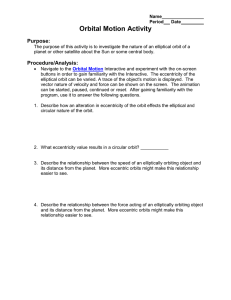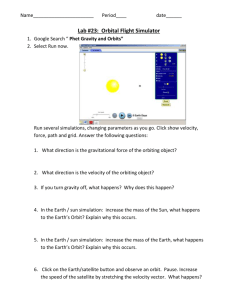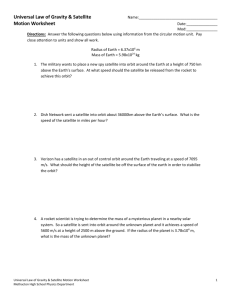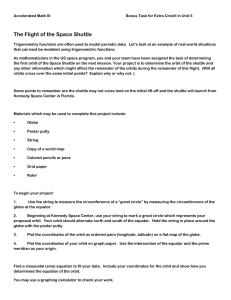Chapter 3
advertisement
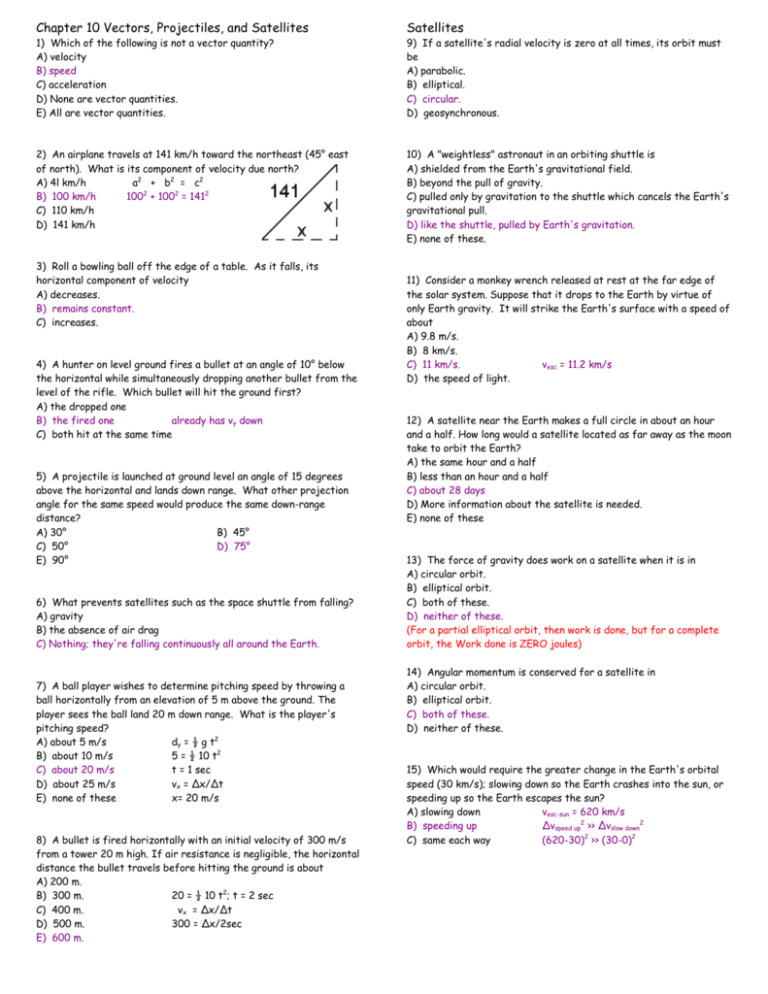
Chapter 10 Vectors, Projectiles, and Satellites Satellites 2) An airplane travels at 141 km/h toward the northeast (45° east of north). What is its component of velocity due north? A) 4l km/h a2 + b2 = c2 B) 100 km/h 1002 + 1002 = 1412 C) 110 km/h D) 141 km/h 10) A "weightless" astronaut in an orbiting shuttle is A) shielded from the Earth's gravitational field. B) beyond the pull of gravity. C) pulled only by gravitation to the shuttle which cancels the Earth's gravitational pull. D) like the shuttle, pulled by Earth's gravitation. E) none of these. 1) Which of the following is not a vector quantity? A) velocity B) speed C) acceleration D) None are vector quantities. E) All are vector quantities. 3) Roll a bowling ball off the edge of a table. As it falls, its horizontal component of velocity A) decreases. B) remains constant. C) increases. 4) A hunter on level ground fires a bullet at an angle of 10° below the horizontal while simultaneously dropping another bullet from the level of the rifle. Which bullet will hit the ground first? A) the dropped one B) the fired one already has vy down C) both hit at the same time 5) A projectile is launched at ground level an angle of 15 degrees above the horizontal and lands down range. What other projection angle for the same speed would produce the same down-range distance? A) 30° B) 45° C) 50° D) 75° E) 90° 6) What prevents satellites such as the space shuttle from falling? A) gravity B) the absence of air drag C) Nothing; they're falling continuously all around the Earth. 7) A ball player wishes to determine pitching speed by throwing a ball horizontally from an elevation of 5 m above the ground. The player sees the ball land 20 m down range. What is the player's pitching speed? A) about 5 m/s dy = ½ g t2 B) about 10 m/s 5 = ½ 10 t2 C) about 20 m/s t = 1 sec D) about 25 m/s vx = Δx/Δt E) none of these x= 20 m/s 8) A bullet is fired horizontally with an initial velocity of 300 m/s from a tower 20 m high. If air resistance is negligible, the horizontal distance the bullet travels before hitting the ground is about A) 200 m. B) 300 m. 20 = ½ 10 t2; t = 2 sec C) 400 m. vx = Δx/Δt D) 500 m. 300 = Δx/2sec E) 600 m. 9) If a satellite's radial velocity is zero at all times, its orbit must be A) parabolic. B) elliptical. C) circular. D) geosynchronous. 11) Consider a monkey wrench released at rest at the far edge of the solar system. Suppose that it drops to the Earth by virtue of only Earth gravity. It will strike the Earth's surface with a speed of about A) 9.8 m/s. B) 8 km/s. C) 11 km/s. vesc = 11.2 km/s D) the speed of light. 12) A satellite near the Earth makes a full circle in about an hour and a half. How long would a satellite located as far away as the moon take to orbit the Earth? A) the same hour and a half B) less than an hour and a half C) about 28 days D) More information about the satellite is needed. E) none of these 13) The force of gravity does work on a satellite when it is in A) circular orbit. B) elliptical orbit. C) both of these. D) neither of these. (For a partial elliptical orbit, then work is done, but for a complete orbit, the Work done is ZERO joules) 14) Angular momentum is conserved for a satellite in A) circular orbit. B) elliptical orbit. C) both of these. D) neither of these. 15) Which would require the greater change in the Earth's orbital speed (30 km/s); slowing down so the Earth crashes into the sun, or speeding up so the Earth escapes the sun? A) slowing down vesc-sun = 620 km/s B) speeding up Δvspeed up2 >> Δvslow down2 C) same each way (620-30)2 >> (30-0)2

